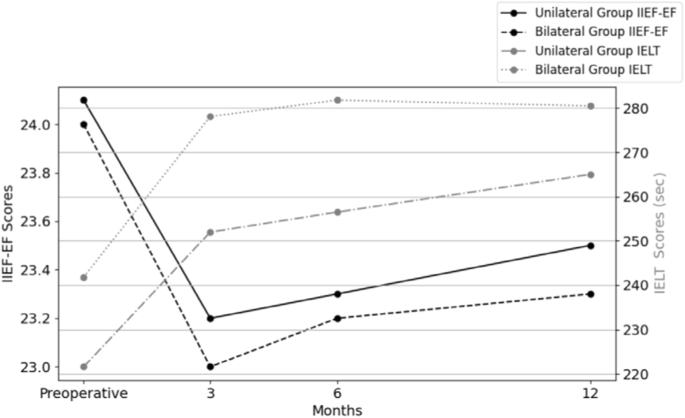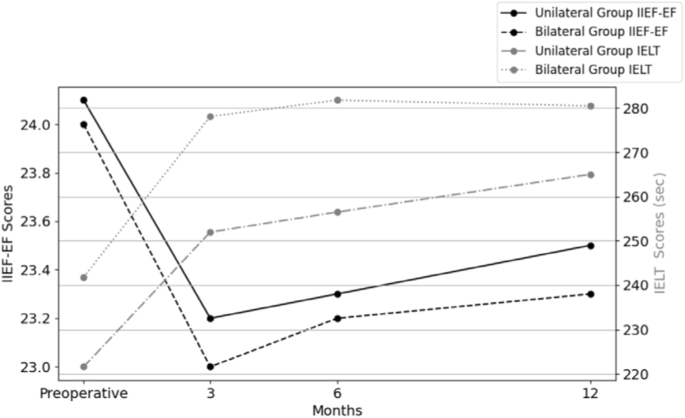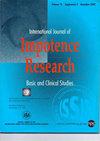阴茎骨折中单侧和双侧海绵体破裂的勃起和射精功能结果比较。
IF 2.8
3区 医学
Q2 UROLOGY & NEPHROLOGY
引用次数: 0
摘要
本研究旨在比较阴茎骨折中单侧和双侧海绵体破裂的勃起和射精功能结果。研究回顾性分析了 2020 年 6 月至 2023 年 1 月期间 60 例患者的数据。根据受影响的阴茎海绵体(单侧和双侧)将患者分为两组。比较了患者术前和术后第 3、6 和 12 个月的阴道内射精-延迟时间(IELT)自我估计值、国际勃起功能指数-勃起功能(IIEF-EF)评分以及是否存在尿道损伤。18.3%的患者发现双侧海绵体骨折。两组患者在第 3 个月、第 6 个月和第 12 个月的 IIEF-EF 评分均显著低于术前评分(单侧组:24.1 ± 2.7 vs 23.2 ± 3.5 和 23.3 ± 3.4,分别为 p = 0.011 和 0.014;双侧组:24 ± 1.9 vs 23 ± 1.8 和 23.2 ± 1.5,分别为 p = 0.027 和 0.047)。两组术前和术后第 12 个月的 IIEF-EF 评分均无明显差异(单侧组:24.1 ± 2.7 vs 23.4 ± 3.6,p = 0.207;双侧组:24 ± 1.9 vs 23.2 ± 1.5,p = 0.057)。两组患者在术后第 3、6 和 12 个月的自测 IELT 均比术前有显著提高(单侧组:221.6 ± 81.8 vs 252 ± 94.6、256.5 ± 97.6 和 250.5 ± 104.8,P 0.05)。总之,在 12 个月的随访中,两组患者的勃起功能均无明显差异,且两组患者自我估计的 IELT 均有延长。此外,在任何一次随访中,两组之间均未发现差异。为了解释单侧和双侧损伤对勃起和射精功能的影响,有必要对更多患者进行进一步研究。本文章由计算机程序翻译,如有差异,请以英文原文为准。


Comparison of erectile and ejaculatory functional outcomes between unilateral and bilateral cavernosal rupture in penile fractures
This study aimed to compare the erectile and ejaculatory functional outcomes of unilateral and bilateral ruptures of the corpus cavernosum in penile fractures. Sixty patients’ data were analyzed retrospectively between June 2020 and January 2023. The patients were divided into two groups based on the affected corpus cavernosum (unilateral and bilateral). Preoperative and postoperative 3rd-, 6th-, and 12th-month self-estimated intravaginal-ejaculation-latency-time (IELT), and international index of erectile function-erectile function (IIEF-EF) scores as well as the presence of urethral injury were compared. Bilateral corpus cavernosum fractures were detected in 18.3% of the patients. The IIEF-EF scores of both groups at 3rd-, 6th-, and 12th-month were found to be significantly lower than the preoperative scores (unilateral group:24.1 ± 2.7 vs 23.2 ± 3.5 and 23.3 ± 3.4, respectively, p = 0.011 and 0.014, respectively; bilateral group: 24 ± 1.9 vs 23 ± 1.8 and 23.2 ± 1.5, respectively, p = 0.027 and 0.047, respectively). No significant difference was found between the preoperative and the postoperative 12th month IIEF-EF scores in either group (unilateral group: 24.1 ± 2.7 vs 23.4 ± 3.6, p = 0.207;bilateral group:24 ± 1.9 vs 23.2 ± 1.5, p = 0.057). The self-estimated IELTs of both groups at the postoperative 3rd, 6th, and 12th months demonstrated a significant increase from the preoperative values (unilateral group: 221.6 ± 81.8 vs 252 ± 94.6, 256.5 ± 97.6, and 250.5 ± 104.8, respectively, p < 0.001; bilateral group:241.8 ± 61.6 vs 278.1 ± 55.4, 281.8 ± 56.1, and 283.6 ± 54.2, respectively, p = 0.041, 0.030, and 0.047, respectively). The changes in self-estimated IELTs and IIEF-EF scores between the preoperative period and the postoperative 3rd, 6th, and 12th-months were compared, and no statistical difference was found between patients with unilateral and bilateral corpus cavernosum fractures (p > 0.05). In conclusion, no significant difference in erectile function was found in either group at the 12-month follow-up, and the self-estimated IELTs were found to be prolonged in both groups. Furthermore, no difference was noted between the groups at any follow-up. To explain the effects of unilateral and bilateral injuries on erectile and ejaculatory functions, further studies with a larger-number of patients are necessary.
求助全文
通过发布文献求助,成功后即可免费获取论文全文。
去求助
来源期刊

International Journal of Impotence Research
医学-泌尿学与肾脏学
CiteScore
4.90
自引率
19.20%
发文量
140
审稿时长
>12 weeks
期刊介绍:
International Journal of Impotence Research: The Journal of Sexual Medicine addresses sexual medicine for both genders as an interdisciplinary field. This includes basic science researchers, urologists, endocrinologists, cardiologists, family practitioners, gynecologists, internists, neurologists, psychiatrists, psychologists, radiologists and other health care clinicians.
 求助内容:
求助内容: 应助结果提醒方式:
应助结果提醒方式:


